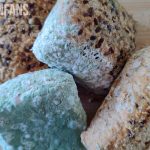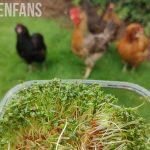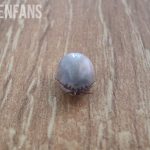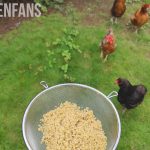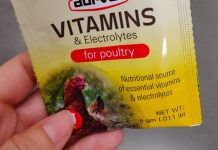Can Chickens Eat Rhubarb?
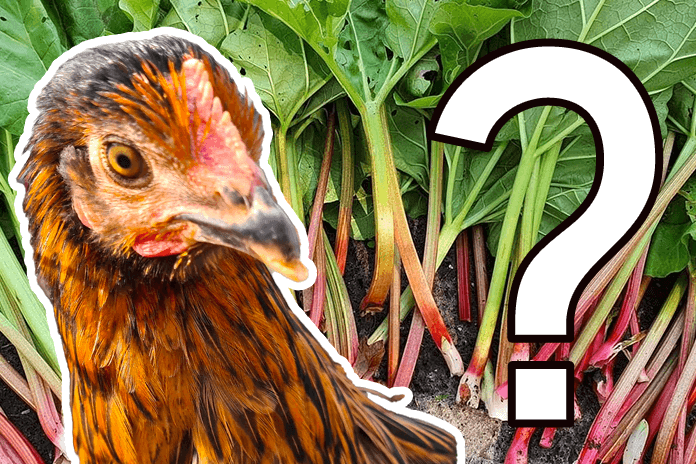
Yes, chickens can eat rhubarb, but only in moderation.
They can eat both the leaves and the stalks. Although rhubarb contains toxins, they most probably won’t die from eating some rhubarb once. There are, however, some caveats worth noting. Rhubarb is not a good food source for chickens, and they should especially avoid the leaves.
You might have read that rhubarb leaves contain toxic substances and are poisonous.
Let’s see if that’s true.
- What is rhubarb?
- Chemical composition of rhubarb
- Toxicity of Oxalic acid
- Toxicity of Anthraquinone
- Rhubarb Health Effects
- Conclusion: Should you worry when your chickens ate rhubarb?
What is Rhubarb
Rhubarb (Rheum rhabarbarum) is a popular vegetable with a strong tart taste. It’s commonly stewed with added sugar as an ingredient for pies and jam. In the United States, people sometimes call it the Pie Plant.

People did not always eat rhubarb. Before the 20th century, several varieties were solely used in traditional Chinese medicine. It was only after sugar became affordable and widely available that culinary rhubarb came into the picture. Homesteads started to cultivate rhubarb as it’s easy to grow the perennial in a sunny, well-drained location.
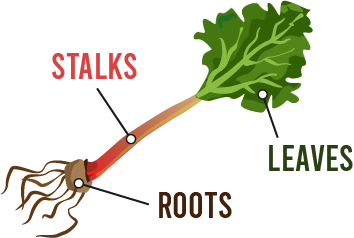
If we want to know whether chickens can eat rhubarb, we have to look at the entire plant and its individual parts. Rhubarb consists of the popular leafstalks, rhubarb leaves, roots, and flowers.
Chemical Composition of Rhubarb
Rhubarb is 95% water contained in fibers. It is an excellent source of vitamin K (28% per 3.5oz of our Daily Value) and contains some vitamin C. Although it also contains some other healthy micronutrients for chickens, those amounts are insignificant.
To answer whether chickens can eat rhubarb, we must dive into phytochemistry. More specifically, the secondary metabolites of plants. These organic compounds are not directly involved in the plant’s normal growth, like toxins. Metabolites often serve the role of defense mechanisms that prevent the plant from being eaten by animals.
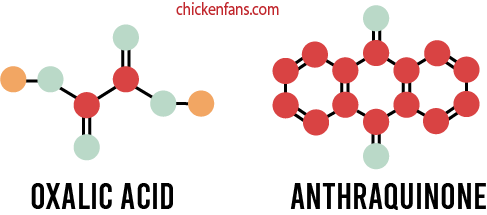
The most important chemical compounds for chickens are:
- Oxalic Acid – an organic metabolite found in many vegetables and fruits such as spinach, endive, and sweet potatoes. The body binds with minerals, such as iron and calcium, to form oxalates. High concentrations can cause kidney stones and other health problems. It also occurs naturally as a by-product of the digestion of humans and chickens.
- Anthraquinone Glycosides – a group of brown-red secondary metabolites that occur in Rhubarb in the form of Emodin and Rhein. They prevent water absorption in the intestines and have a laxative effect. They were used in traditional Chinese medicine. Anthraquinone glycosides play an active role in the body and have many interesting properties.
- Parietin – an orange-yellow pigment that can slow down the growth of cancer cells and is known to kill human leukemia cells. It’s an anthraquinone derivate that is also known as physcion.
The question is whether these compounds are safe or not for our beloved chickens.
We’ll start with Oxalic Acid, the most feared compound among poultry farmers.
Oxalic Acid
Oxalic acid is a poisonous substance that is present in many vegetables. During World War I, rhubarb leaves were incorrectly considered a healthy substitute for vegetables in Britain, and people have actually been poisoned after eating Rhubarb leaves.
Toxicity Class
As bad as that might sound, oxalates actually occur naturally in the human body. Oxalates of rhubarb are in toxicity class 3 for plants:
| Class | Impact |
| 1 | plants that cause severe illness or death |
| 2 | plants that may cause minor conditions like vomiting or diarrhea |
| 3 | plants containing oxalates, causing irritation, stomach upset, and burning pain |
| 4 | plants that cause skin rash or irritation |
A chicken that has eaten rhubarb is not immediately going to die. However, category three doesn’t make it look like it’s completely innocent, either. Let’s see what the oxalic acid of rhubarb is doing in the chicken’s body.
Oxalic Acid in the Chicken’s Body
Oxalic acid is an organic acid that binds with minerals in the body, such as iron and calcium, forming oxalate. The terms oxalic acid and oxalate refer to the same compound. It’s called oxalic acid when it’s in the chicken’s acidic glandular stomach (~pH1.5-3.5) and oxalate in less acidic environments, where it binds, such as the intestines.
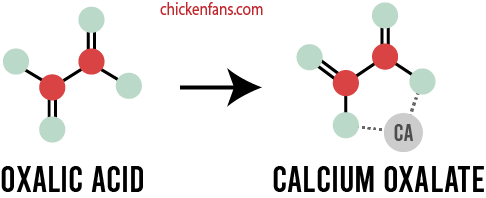
These oxalates bind to calcium and iron in the food, which prevents the body from absorbing calcium and iron. High levels of oxalates can even remove iron and calcium from the body. This is especially true in the presence of fibers, and rhubarb is a source of fiber.
However, it does not react with all the other food chickens eat. For example, if you drink a glass of milk, the oxalates in spinach will not prevent the absorption of the calcium in the milk.
Oxalates are generally excreted via the chickens’ droppings. However, high levels of oxalates are linked to a higher risk for kidney stones. Especially in cases of dehydration, oxalates can form crystals. In humans, most of the oxalate in urine is a by-product of their own digestion rather than food.
Toxicity of Oxalic Acid in Chickens
To find out if chickens can eat rhubarb, we will look at the amount of oxalate in rhubarb and the point where consumption becomes lethal.
How much Oxalic Acid is in Rhubarb?
The oxalate concentration depends on the variety of rhubarb, the application of fertilizers, the soil, and the plant’s maturity. So there is a range, but it doesn’t vary very much.
The leaves contain a little bit more oxalates:
| Rhubarb Leaf | 0.59 – 0.72 |
| Rhubarb Stalk | 0.39 – 0.54 |
| Spinach | 0.32-1.26 (~0.97) |
On average, 0.5% of the plant is oxalate.
Remark that the oxalate levels in rhubarb leaves don’t differ much from other vegetables. They are also still much lower than the concentration in spinach.
But we’ve found studies on species of culinary rhubarbs that report higher concentrations of water-soluble oxalates up to 3.13% (1.56-6.03%).
How much rhubarb can chickens eat?
The most pessimistic LD50 (median lethal dose) for oxalates is 375mg/kg body weight. Other sources report an LD0 (minimum quantity to be fatal) of 600mg/kg. These values express the risk of dying from kidney stone disease (nephrolithiasis).
A human of 65kg needs to eat 4 to 8kg of leaves to obtain such a lethal dose, which is enormous.
What about chickens? Let’s calculate:
- For an Australorp of 5.9lbs (2.7kg) this means ~7-11oz (200-300g) of rhubarb leaves would give him ~50% risk of dying.
- For a lightweight Leghorn of 4,4lbs (2kg) this means ~5.3-8.5oz (150-240g) of rhubarb leaves.
These values are about twice the amount of food the chickens usually eat: about 3.5 ounces (~100g) per day.
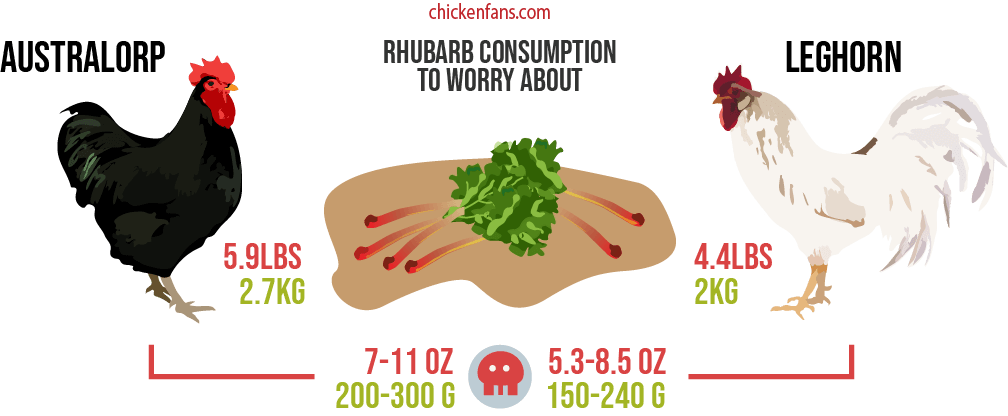
That’s a lot of rhubarb, but it’s not an insane amount, either.
Why you shouldn’t worry too much about these numbers
These numbers apply when the oxalate is injected immediately into the bloodline. In reality, the chickens will play with their food and mix it with other food. They won’t eat everything in just one single bite. Furthermore, it’s their instinct to stay away from food that makes them feel sick, and they don’t usually overeat. Overeating will give them abdominal pain from the anthraquinones.
We used the pessimistic lethal doses for humans and rats. The digestive system of chickens is much more efficient in breaking down vegetables and greens. They excrete vast amounts of oxalate via their urine before it can bind. Spinach contains more oxalates and is often recommended as a food source.
Scientific studies have reported that they found no poisoning symptoms after hens ate fresh rhubarb leaves. When you search online, you will find plenty of stories of chickens that ate rhubarb leaves and did not show any signs of illness at all. Acute fatal poisonings in chickens due to eating rhubarb are very rare.
Should you ever worry about oxalate intoxication?
As we’ve seen, oxalic acid is poisonous, so use common sense to assess the situation. If you have small pullets, grown-up chicks, or your chickens have known kidney issues, be careful and keep an eye on them. Also, if you’ve been feeding your chickens rhubarb leaves regularly, there might be an elevated risk for kidney stones.
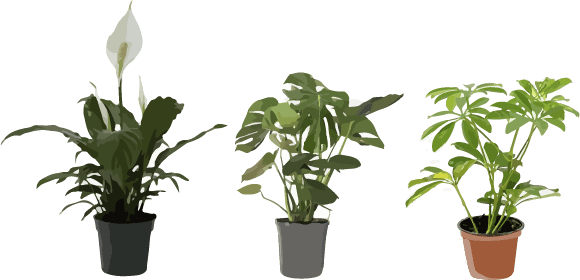
Oxalate poisoning occurs more frequently with smaller birds like cockatiels eating common houseplants. Plants like the Umbrella Plant, Peace Lilly, Dumb Cane, Photos, and Philodendron contain large amounts of oxalates. So if you are keeping Silkies in-house, rhubarb might not be the worst enemy.
If you notice any symptoms, contact your veterinarian or poison control center.
Impact of Oxalic Acid on Egg Formation
So your chickens won’t immediately fall dead after eating some rhubarb. But what about the calcium levels and egg formation?
Oxalic Acid and Calcium in Chicken Eggs
Oxalic acid in rhubarb binds to calcium, so the chicken’s body can’t absorb the calcium anymore.
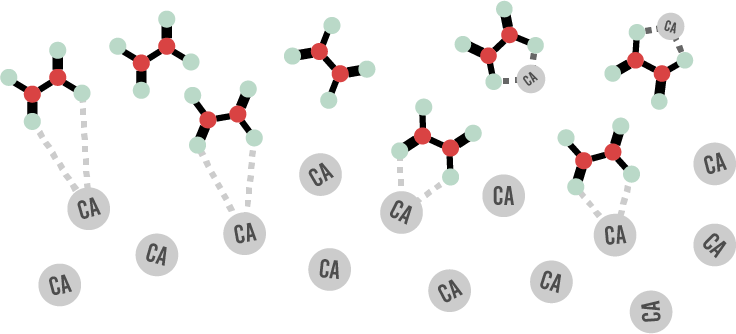
Calcium is a crucial ingredient for hens to produce quality eggs. Calcium carbonate is the primary building block of a chicken’s eggshell.
However, the oxalic acid of rhubarb will primarily bind with the calcium present in the rhubarb itself. When your hens have extra calcium from other calcium sources, the intestines will absorb that calcium.
So don’t start eliminating all sorts of food from your hen’s diet because they contain oxalic acid. Oxalates are very common in leafy greens. If rhubarb and spinach are the only things your hens would eat, it would be a problem because they would ultimately be deprived of all their calcium sources.
What does science say?
Scientific studies have reported a decrease in calcium after adding oxalic acid to poultry feed. They added the oxalate levels of rhubarb (0.5-0.8%) to the chicken’s food for two weeks. After two weeks, they measured a reduction in calcium per egg. More oxalic acid resulted in less calcium per egg.
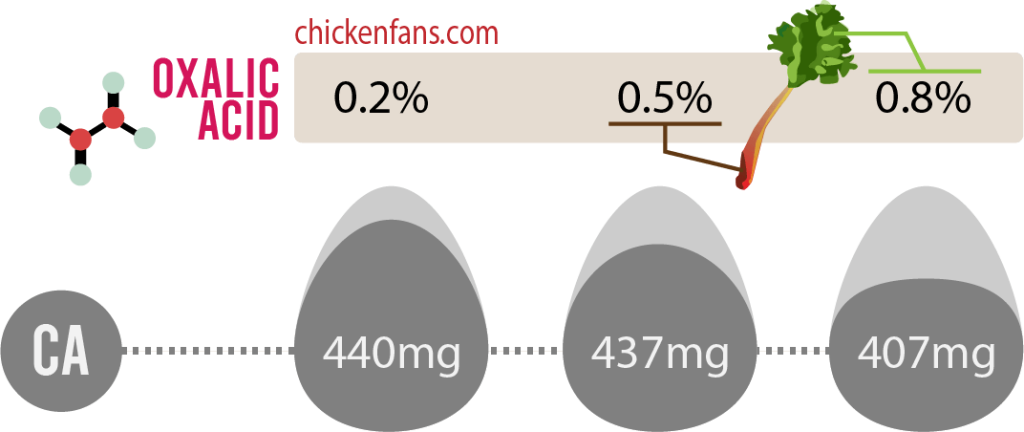
The resulting eggs are still in the normal range but contain less calcium than the hens’ eggs before adding oxalates to their feed. Oxalates didn’t impact the weight of the eggs, the egg yolk, or the egg whites. In the end, shell thickness varies more with age and seasonal effects. (QURESHI, Azhar, 2011; Zhou et al., 1992; Tamim and Angel, 2003)
What if your chickens have eaten a vast amount of rhubarb leaves?
If your chickens eat large amounts of rhubarb leaves, make sure they have calcium sources available, like crushed oyster shells.
We’ve covered much about oxalates, but what about the other metabolites?
Anthraquinone Glycosides
The roots and stems of rhubarb contain brown-red chemical compounds called anthraquinones, such as emodin and rhein. These are active ingredients used in traditional Chinese medicine. They have laxative, antibacterial and anti-inflammatory effects. However, long-term consumption is now linked to kidney failure.

- Emodin is applied as an antiviral compound against SARS-CoV-2, the coronavirus that causes COVID-19. It inhibits the formation of the Spike-ACE2 protein. The antiviral activity of emodin is also effective against other coronaviruses. The avian coronavirus that affects chickens is Infectious Bronchitis Virus (IBV). IBV-infected hens will lay much fewer eggs, and the quality of the eggs will drop rapidly.
- Rhein is an antibacterial agent for bacteria found on the upper respiratory tract and skin.
- Parietin (physicion) is a naturally occurring anthraquinone derivative that can slow down the growth of cancer cells. Tumors show uncontrolled growth, and parietin stimulates the body’s mechanisms for programmed cell death (apoptosis).

So far, so good. Are there any adverse side effects of anthraquinones in chickens?
Anthraquinones and their glycosides are secondary metabolites known for their laxative effect. Chinese rhubarb (rheum palmatum) is used in traditional Chinese medicine as a laxative. Anthraquinones prevent water absorption in the chicken’s intestines and, at the same time, stimulate the peristalsis (contraction). These contractions can be excruciating for the hens.
Rhubarb Health Effects
Let’s summarize some of the health effects we’ve discussed to see if our beloved chickens can eat rhubarb.
- Diarrhea – can be caused by the laxative effects of anthraquinones in rhubarb that prevent water absorption in the chicken’s intestines, will come together with abdominal pain.
- Egg Quality – regular feeding with high oxalate feeds, such as rhubarb leaves, can result in a drop in calcium concentrations in the eggs. Make sure to add enough other calcium sources to the feed, so the hens won’t get deprived of calcium sources. Most of the calcium in rhubarb (and other vegetables like spinach) is bound by oxalates and can’t be used for egg formation and calcium reserves.
- Hypocalcemia – oxalic acid consumption will reduce the total amount of calcium and magnesium available for the chicken, ultimately resulting in hypocalcemia and hypomagnesemia. Chickens will start panting and spreading their wings before becoming paralyzed. This won’t happen after eating a single rhubarb leaf, but chronic misfeeding and comorbidities could result in a higher risk. Ensure the chickens have access to feed with the recommended calcium levels and vitamin D.
- Oxalate Nephrosis – a disease where calcium oxalates crystallize in the kidneys to form kidney stones that can be fatal. The oxalate levels in rhubarb leaves are generally too low to be fatal for chickens, but regular consumption can cause damage to the kidneys.
- Acute Renal Tubular Necrosis – a kidney disorder where the tubule cells of the kidneys are damaged. This can occur when chickens consume extremely high levels of oxalate. It is seen in pet birds such as cockatiels that eat houseplants high in oxalates. Most birds will stop eating before developing the disease due to abdominal pain.
Positive Health Effects
There are very few positive health effects. Apart from Vitamine K and C, there are no interesting amounts of micronutrients for chickens in rhubarb.
The only positive application of rhubarb would be the medicinal application of anthraquinones as a laxative. It can combat roundworms and tapeworms as a natural product, combined with ground pumpkin or courgette seeds. However, no plants or herbs can completely remove worms in chickens.
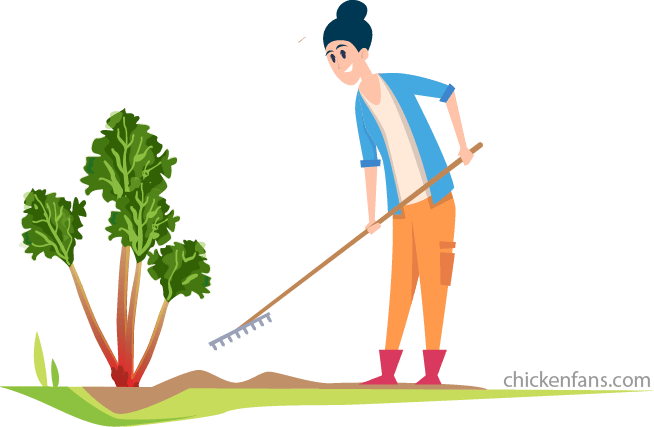
Rhubarb is just not a recommended food source for chickens. It’s the other way around: chicken manure is an excellent fertilizer for rhubarb to grow and produces slightly more prominent and stronger roots!
Should you worry when your chickens eat rhubarb?
If your chickens ate some rhubarb, don’t panic. The rhubarb leaves have higher levels of oxalic acid, but so does spinach.
Ensure they have access to regular food and water, and they will usually be fine. We won’t recommend rhubarb as food. It’s just a terrible food source as it contains very few micronutrients, and long-term use can damage the chicken’s kidneys.
If the hens show signs of gastrointestinal issues such as diarrhea, it’s probably due to the anthraquinones in the rhubarb. Offer them some calcium-rich food such as oyster shells, as the oxalates will render some of the calcium in the food unusable by the body.
That said, evaluate your specific situation. If you have small-sized chickens, a sick Polish chicken, or little chicks, keep an eye on them.
Last but not least, don’t hesitate to contact your veterinarian or poison control center when you notice some irregularities.
If you want to learn more about chicken feed, please consult our ‘Chicken Food Page‘ to go and see every specific food article we address. Including all articles on what chickens can and can not eat. Or go to our listicle food summary on ‘The Classroom‘.
Credits Featured Image Background: @vthetzonnetje (IG)
